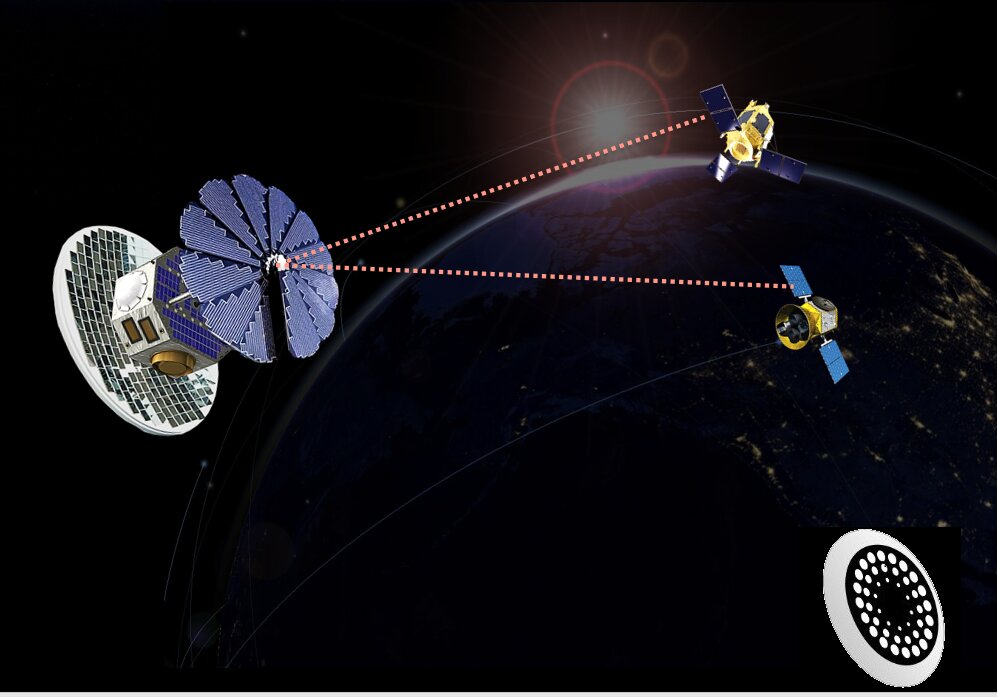The University of Surrey and Space Power are tackling the problem of powering satellites in Low Earth Orbit (LEO) during their eclipse period when they cannot see the sun. By collaborating on a space infrastructure project, the joint team will develop new technology which uses lasers to beam solar power from satellites under solar illumination to small satellites orbiting closer to Earth during eclipse. The wireless, laser-based power beaming prototype will be the first developed outside of governmental organizations and is aiming for commercialisation by 2025.
Wireless power beaming is a critical and disruptive technology for space infrastructure and will provide auxiliary power to increase the baseline efficiency of small satellites in LEO. The technical side of the project will use the highly specialized laser laboratories and optical systems developed at the University of Surrey’s Department of Physics and Advanced Technology Institute, which are world leaders in the development and implementation of laser and photovoltaic-based technologies. The first Space Power product will be designed as a plug-and-play system for satellite manufacturers to include in their offering to their LEO constellation customers.
Without new power technologies like this, which will enable small satellites to function all the time, more satellites are needed, with the resultant costs, launch emissions and contribution to space debris. As humanity finds more ambitious and useful tasks for small satellites, the problem grows.
The project is part of the £7.4 million national SPRINT (SPace Research and Innovation Network for Technology) program. SPRINT provides unprecedented access to university space expertise and facilities and helps businesses through the commercial exploitation of space data and technologies. The power beaming prototype work follows on from an initial feasibility study by Space Power and the University of Surrey on laser transmission funded through the SME Innovation Voucher scheme. Now, the team will investigate and verify the efficiency benefits of laser-based power beaming, develop the new technology, and obtain data to enable them to design a prototype for small satellites in space.
Professor Stephen Sweeney, Professor of Physics at the University of Surrey, said that “the University of Surrey has a long track record in photonics and space research and brings unique expertise in both high power lasers and photovoltaics technologies. We have many years of experience in optical wireless power and are delighted to work with Space Power to help develop such technologies for space-based applications.”
Keval Dattani, Director of Space Power said that “the SPRINT project is an important development from our feasibility study with the University of Surrey that enables us to approach customers with confidence and demonstrate the improved efficiencies available by using auxiliary power systems. By focusing on light optics and power beaming, we are looking to increase small satellite operating efficiencies by a factor of between 2X-5X.”
“We have seen the benefits of powering satellites by laser which enables smaller satellites, simpler systems and fewer resources—whilst performing more work to help us understand our planet better. For us, this is a neat solution with long term benefits, not least for lunar outposts and asteroid mining but back here on earth too.”
Image: Dedicated satellites to collect solar energy
Citation:
Revolutionizing satellite power using laser beaming (2022, January 28)
retrieved 28 January 2022
from https://phys.org/news/2022-01-revolutionizing-satellite-power-laser.html
This document is subject to copyright. Apart from any fair dealing for the purpose of private study or research, no
part may be reproduced without the written permission. The content is provided for information purposes only.
For all the latest Science News Click Here
For the latest news and updates, follow us on Google News.

